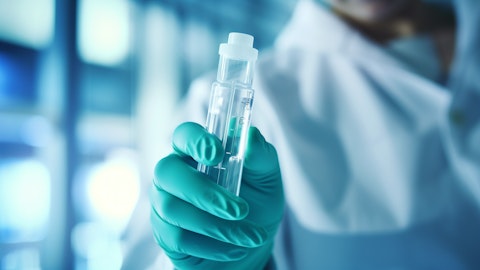Joe Mara: Yeah. Just to add — just to kind of reiterate or add a little bit, Sam, kind of the earlier question around seasonality ties into it and guidance, et cetera. But I think it is important to recognize Epicel meaningfully grew versus where it exited 2022. Sometimes it’s a little bit tough to look at calendar years, but we know it was running in the $6 million to $7 million range. Again, if you just use the last couple of quarters of 2022, it was kind of high 6s. Now we’re above $8 million. I mean, that’s more than 20% growth, which also lines up historically to kind of where we were. And again, as we think about kind of growth on a full year basis, just to reiterate, there’s multiple components there. So we think the volume can be a bit better and we’re starting to see some signs of that with a larger footprint and the share of voice.
But also, as I said earlier, there’s a price component to there as well. So as you think about call low double-digit growth on Epicel, and again, that’s one scenario within our guidance and burn care there can be shifts along the franchise products, but the one I referenced, I mean, that’s below where we were last year. So I certainly think that’s a reasonable expectation. Again, it could vary quarter-to-quarter in terms of how we get there, but we think that’s certainly a reasonable expectation going into the year.
Sam Brodovsky: That’s great. Thanks for taking the questions.
Joe Mara: Thanks, Sam.
Operator: Thank you. One moment for our next question. Our next question comes from George Sellers with Stephens. Please go ahead.
George Sellers: Hey. Good morning and thanks for taking the question. Maybe to shift gears a little bit to the margin guidance, I’m just curious, what does that assume in terms of the improvement driven by price versus NexoBrid and Epicel ramping up? And then what’s also sort of assumed related to investment for commercializing arthroscopic delivery?
Joe Mara: Yeah. So good morning, George, and thanks for the question. So I’ll kind of hit that and just make sure we talk a little bit about some of the guidance beyond the revenue So as we talked about we’re expecting improvement in gross margin from high 60s last year to 70. On adjusted EBITDA, we ended last year on a full year basis at 17. We think we could be around that 20% number this year. First off, to just kind of point out, I did comment in my prepared remarks, but as you think about that guidance, I would say, it’s also important to think about the quarterly progression and the trends there. So the way kind of our business works with just some of the seasonality and whatnot is we typically see improving kind of margins throughout the year, particularly Q1 often ends up being kind of on the low end and then Q4 obviously ends up being on the higher end.
So there’s going to be a progression, I would say, and you can really reference last year’s trajectory and assume probably some something similar on a year-over-year basis with some improvement and there could obviously be some puts and takes within quarters. In terms of kind of what’s driving kind of the margin improvement, I would say, and I guess, on the last piece on the OpEx side just before I go there, we did talk about call it mid-160s, I think, I mentioned $165 million from an OpEx perspective, and from an investment perspective, it’s the things we’ve been talking about. So certainly we’ll want to make sure Arthro is set up for success. There’s some spend there to kind of get ready from a commercial perspective, to make sure the instruments are ready.
So that is clearly a priority investment this year to make sure that it’s successful. And then things like ankle from a lifecycle management and other investments, just they’re probably more modest, but things to make sure things like NexoBrid are kind of continuing to track. So those remain the investment areas. Our — certainly our leverage broadly is driven by the topline growth being sustained at a high level. We certainly want to make sure we manage our OpEx growth at a lower level than that and we did that last year, and that’s certainly our plan this year. In terms of kind of what flows through to the margin, certainly as we talked about NexoBrid kind of fits into the margin profile from a gross margin perspective. So that’s helpful.
And then some of that to your question, obviously, as you take increases in price, that certainly helps from a gross margin perspective. But there’s also just some natural leverage in the business and I think we’re starting to see where, again, if we can kind of manage our costs at a lower level, then overall revenue, we’re going to see that pull through. And then lastly, I talked about in the fair remarks, but you can also see just we also talk about pull-through in terms of how much is dropping to the bottomline. Like if you look at Q4 last year that was really strong in the adjusted EBITDA line pull-through and gross margin, both Q4 and full year kind of that 80% range. So I think that’s kind of where it needs to be last year and something we’re focused on maintaining this year.
George Sellers: Okay. That’s really helpful color. I appreciate all that detail. You touched on MACI ankle. Just curious with that clinical study initiating in 2025 and then you’ve also talked about getting close to 30% adjusted EBITDA margins in 2025 and beyond, how do we sort of reconcile those two items and what should we think about in terms of the investments for launching that clinical trial?
Nick Colangelo: Yeah. Hey, George. Nick. As we’ve talked about this study has always been sort of planned and is included in sort of the longer term projections that we’ve given. This is not a large study by pharma or biotech standards. It’ll be very much like the summit study that was the pivotal study for MACI in the knee somewhere call it up around 200 patients. It’ll take a couple of years to enroll. So it’s kind of single-digit-million dollars kinds of study and so it’s, again, not compared to our overall sort of OpEx and investment. It’s really not that significant.


